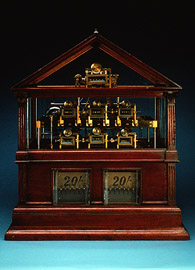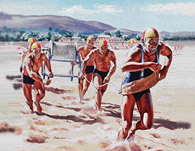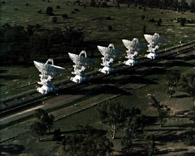| |
Overview of Australian innovation in the twentieth century
Australia became a federation of states, rather than a group of colonies, on the first day of the twentieth century, a century that was to see great changes in industry and everyday life.
Transport
| The trip from Europe to Australia,
which took months in 1901, could be completed in less than a day by the
end of the century. The aeroplane was of course an American innovation,
but it was embraced by Australians, who instituted the first round-the-world
air service and the first flying doctor service and contributed some of
the century?s many technical innovations in aeronautics, including the black
box flight recorder. |
|
The Michell thrust bearing is a great example of an innovation based on consideration of basic science. Often in the past it had been true that technology led and science followed, but the reverse was increasingly common during the twentieth century.
The new bearing enabled the building of large turbine-powered ships, which were crucial to the burgeoning of trade, and huge turbo-generators, which allowed electricity to become the major power source of the century.
The car was perhaps the dominating technology of the century. It transformed cities and ways of life. The automotive industry employed many people directly and indirectly and became a major sector of the economy.
The distinctive Australian six-cylinder car evolved through a combination of local and imported innovation. With more and more cars on the road, the demand for safety features grew. Australia?s most important innovation in this area was probably the baby safety capsule.
Agriculture and Food
Agriculture was a major source of exports, including
wool, wheat, meat, cotton, rice and wine. The national research organisation,
CSIRO, made many important contributions to agriculture and food processing.
In the early years of the century, the Sunshine
header harvester and Rotavator rotary hoe continued a tradition of innovation
in agricultural machinery.
|
|
Many new varieties of plants and animals were bred for local conditions, including Federation wheat, the Granny Smith apple, and the Australian cattle dog. In 1989, Australia became the first country to release a genetically modified organism to the market, Nogall pest control for roses and fruit trees.
Energy and Environment
Demand for electricity and oil increased dramatically
during the century, as did the infrastructure to deliver them throughout
the country.
Most of Australia’s electricity is generated
in coal-fired power stations, but hydro-electricity is dominant in Tasmania.
The major hydro scheme to be built on the mainland was the Snowy Mountains
Scheme, which was innovative both in its conception and in some features
of its construction.
|
|
Debate over environmental issues became significant from the 1970s, with the drowned Lake Pedder in Tasmania and the depleted Snowy River becoming symbols of controversy. Research increased into other forms of renewable energy. Australia led the world in efficient conversion of solar energy to electricity with the buried contact solar cell and enjoyed export success with Solahart water heaters.
As the driest inhabited continent, Australia has long fostered innovation in pipes. The innovative Rib Loc pipe is being wound out to line the inside of old pipelines around the world to keep them in usable condition.
Manufacturing
Australia?s mineral wealth is the basis of much of its manufacturing industry. Mineral processing is an area where there has been much local innovation, from the 1904 froth flotation process for concentrating ore, to the 1983 Isasmelt process for separating metals from their ores.
Making paper by hardwood pulping, rather than from softwood, was an early success story, but its success led to wood-chipping of large areas of native forest.
|
|
Plastic was the material that dominated the century. It supplanted natural materials and even metals in many manufactured goods. One notable Australian innovation was the polymer banknote, which is harder to forge and lasts longer than a paper banknote.
Communication and Information Technology
|
Computers changed many aspects of life in the second
half of the century. An early Australian contribution to the development
of computing was the automatic totalisator, used widely to facilitate
gambling.
The most significant Australian innovation in communication
is probably the Cochlear implant, which helps profoundly deaf people hear.
Most local innovations in computing have been in
software rather than hardware, but two significant hardware products are
the Mountbatten brailler and Nomad computer interface, which are both
designed to assist blind people.
|
|
A major change in work practice and social interaction towards the end of the century was the establishment of call centres. A key technology in this trend, the Ericsson phone queuing system, was developed in Australia. This innovation illustrates another trend, the dominance of multi-national companies such as Ericsson in the nation?s economy.
Household and Clothing
|
The Hills clothes hoist and Victa mower are innovations that symbolise
the Australian suburban lifestyle. The dual flush toilet led the world
in urban water efficiency. All three were important in the establishment
or growth of major Australian companies.
Speedo swimwear also launched a company (as well as generations of competitive
swimmers) on the path to success, but this company was eventually sold
overseas. Other innovative clothing companies to make their mark on the
world included Mambo and Balarinji
|
|
Over many years, CSIRO made a series of innovations in wool technology that saved this fibre from losing out to cotton and synthetics in the clothing market. While Australia no longer "rides on the sheep?s back" (in an economic sense) as it did until the 1960s, wool was still a major export at the century?s end.
Leisure
|
Early Australian cinema was responsible for the first feature-length
movie, and other local innovations in movie-making followed. Television
was probably the major twentieth century innovation in leisure, and again
Australians made contributions, for instance Racecam TV sport coverage,
which gave viewers a sense of involvement in car racing and led to other
innovations in sports broadcasting.
|
|
Australian innovations in outdoor leisure included the surf lifesaving movement and the Super Sopper, which removes water from sports grounds to allow players to get on with their games.
The Sydney Opera House was one of the landmark buildings of the century. And the Fairlight CMI synthesiser brought computers to music-making and new sounds to musical performances.
Health
|
A polio epidemic in the 1930s saw the innovative Both brothers develop
and manufacture the Both respirator, an affordable alternative to the
‘iron lung’ that helped polio patients breathe. In 1981, Colin
Sullivan developed the CPAP sleep apnoea control machine to help another
group of patients improve their health by breathing correctly while sleeping.
An Australian team just missed out on being the first to succeed with
human in-vitro fertilisation (IVF), but went on to lead the world in IVF
freezing. Another team improved ultrasound technology so that it became
a widely used technique in medical practice.
The whole area of microsurgery was pioneered in Australia, with instruments
and techniques developed here and training provided to surgeons from around
the world.
|
|
Penicillin was a major innovation whose development was led by the Australian researcher Howard Florey. Medical research has a strong record of achievement in this country, and many of its results have reached the marketplace.
Research
|
Some innovations are used mainly be other researchers, such as the Australia
Telescope. However, this project has had spin-offs in the form of saleable
high tech products as well as contributing to the development of astronomy.
Our ability to analyse the chemical make-up of all parts of our environment
increased greatly during the century.
|
|
The flame ionisation detector was developed in an industrial laboratory. It enabled the technique of gas chromatography to give much better results in detecting the composition of materials. The company that developed it in 1957 made the mistake of not patenting it in Japan which we know with hindsight was emerging to become a major economic power and Australia?s major trading partner.
Another analytical technique, atomic absorption spectroscopy (AAS), was developed by Alan Walsh at the CSIRO and became very widely used. Walsh championed the making of AAS instruments in Australia and so began the country?s successful scientific instrument industry.
Overall however, research areas outside of medicine do not have a strong record of converting local ideas into innovations. Australian governments have tried several schemes to encourage commercialisation of research, and CSIRO and the universities now work more closely with industry than they did in the past.
|
|

















